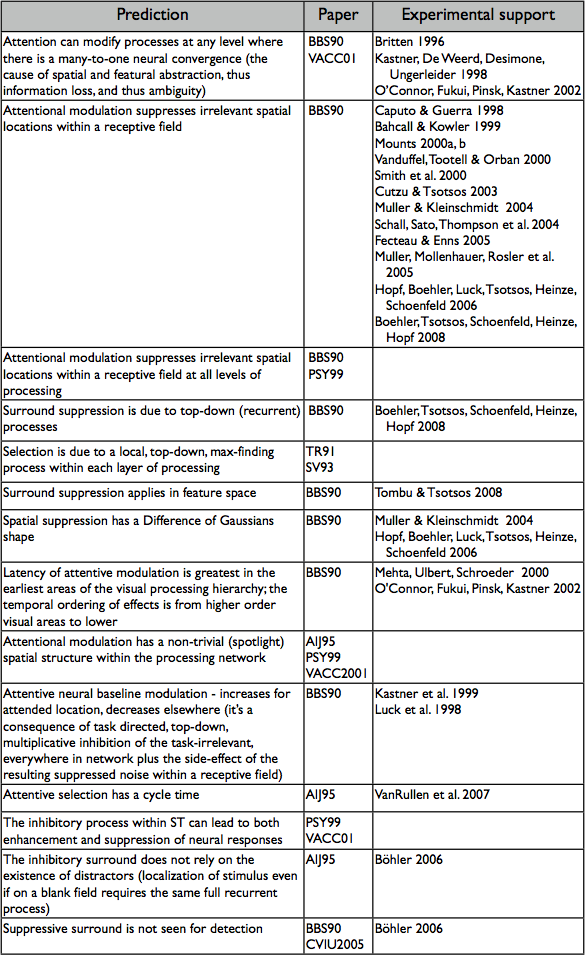Predictions of the ST Model
The following table is updated as new results appear.
Please note that only true predictions are included, that is, characteristics of the ST model that had not been observed experimentally in human or non-human primate vision at the time the prediction is published. ST provides explanations for a wide variety of existing attentional phenomena, but these are not predictions are thus are not included here.
If you have experimental work that supports Selective Tuning, yet is not included here, I hope you will send me a note so I may add it to the list.
-
References
-
‣(BBS90) Tsotsos, J.K. Analyzing Vision at the Complexity Level, Behavioral and Brain Sciences 13-3, p423 - 445, 1990.
-
‣(TR91) Tsotsos, J.K., Localizing Stimuli in a Sensory Field Using an Inhibitory Attentional Beam, October 1991, RBCV-TR-91-37, Dept. of Computer Science, University of Toronto.
-
‣(SV93) Tsotsos, J.K., An Inhibitory Beam for Attentional Selection, in Spatial Vision in Humans and Robots, ed. by L. Harris and M. Jenkin, p313 - 331, Cambridge University Press 1993.
-
‣(AIJ95) Tsotsos, J.K., Culhane, S., Wai, W., Lai, Y., Davis, N., Nuflo, F., Modeling visual attention via selective tuning, Artificial Intelligence 78(1-2), p 507 - 547, 1995.
-
‣(PSY99) Tsotsos, J.K., Triangles, Pyramids, Connections and Attentive Inhibition, PSYCHE: An Interdisciplinary Journal of Research on Consciousness (http://psyche.cs.monash.edu.au/v5/psyche-5-20-tsotsos.html), July 1999.
-
‣(VACC01) Tsotsos, J.K., Culhane, S., Cutzu, F., From Theoretical Foundations to a Hierarchical Circuit for Selective Attention, Visual Attention and Cortical Circuits, p. 285 – 306, ed. by J. Braun, C. Koch, and J. Davis, MIT Press, 2001.
-
‣(CVIU2005) Tsotsos, J.K., Liu, Y., Martinez-Trujillo, J., Pomplun, M., Simine, E., Zhou, K., Attending to Visual Motion, Computer Vision and Image Understanding, Vol 100, 1-2, p 3 - 40, Oct. 2005.
-
-

-
-
•Caputo, G., Guerra, S., (1998). Attentional Selection by Distractor Suppression, Vision Research 38(5), p. 669 - 689.
-
•Cutzu, F., Tsotsos, J.K., The selective tuning model of visual attention: Testing the predictions arising from the inhibitory surround mechanism, Vision Research p. 205 - 219, Jan. 2003.
-
•Bahcall, D., Kowler, E., (1999). Attentional Interference at Small Spatial Separations, Vision Research 39(1), p 71 - 86.
-
•Böhler , C.N. (2006) The spatiotemporal profile of visual attention, Doctoral Dissertation, Der Fakultät für Naturwissenschaften der Otto-von-Guericke-Universität, Magdeburg, Germany.
-
•Böhler, C.N., Tsotsos, J.K., Schoenfeld, M., Heinze, H.-J., Hopf, J.-M., , The center-surround profile of the focus of attention arises from recurrent processing in visual cortex, Cerebral Cortex, (in press)
-
•Britten, K., (1996). Attention is Everywhere, Nature 382, p. 497 - 498
-
•Fecteau, J., Enns, J. (2005). Visual letter matching: Hemispheric functioning or scanning biases?Neuropsychologia 43 1412–1428.
-
•Hopf, J.-M., Böhler C.N., Luck S.J., Tsotsos, J.K., Heinze, H.-J., Schoenfeld M.A. (2006). Direct neurophysiological evidence for spatial suppression surrounding the focus of attention in vision, Proceedings of the National Academy of Sciences, Biological Track 2006 Jan 24;103(4):1053-8.
-
•Kastner, S., Pinsk, M., De Weerd, P.. Desimone, R., Ungerleider., L. (1999). Increased activity in human visual cortex during directed attention in the absence of visual stimulation. Neuron, 22:751-761.
-
•Kastner, S., De Weerd, P., Desimone, R., Ungerleider, L., (1998). Mechanisms of Directed Attention in the Human Extrastriate Cortex as Revealed by Functional MRI, Science 282, p108 - 111.
-
•Loach, D., Frischen, A., Bruce, N., Tsotsos, J.K., (in press). An attentional mechanism for selecting appropriate actions afforded by graspable objects, Psychological Science.
-
•Luck, S. Chelazzi, L., Hillyard, S., Desimone, R. (1997). Neural mechanisms of spatial selective attention in areas V1, V2, and V4 of macaque visual cortex. Journal of Neurophysiology, 77:24-42.
-
•Mehta, A., Ulbert, I., Schroeder, C., 2000. Intermodal selective attention in monkeys. I: distribution and timing of effects across visual areas. Cerebral Cortex 10 (4), 343–358.
-
•Mounts JR. 2000a. Attentional capture by abrupt onsets and feature singletons produces inhibitory surrounds. Percept Psychophys. 62:1485--1493.
-
•Mounts JR. 2000b. Evidence for suppressive mechanisms in attentional selection: feature singletons produce inhibitory surrounds. Percept. Psychophys. 62:969--983.
-
•Muller, A. Kleinschmidt, The attentional spotlights penumbra: center-surround modulation in striate cortex, Neuroreport 15 (6) (2004) 977–980.
-
•Muller, N. G., Mollenhauer, M., Rosler, A. & Kleinschmidt, A. (2005) Vision Res. 45, 1129–1137.
-
•O'Connor, D., Fukui, M., Pinsk, M., Kastner, S., 2002. Attention modulates responses in the human lateral geniculate nucleus. Nat. Neurosci. 5 (11), 1203–1209.
-
•Schall, J.D., Sato, T., Thompson, K., Vaughn, A., Chi-Hung, J. (2004). Effects of search efficiency on surround suppression during visual selection in frontal eye field, J. Neurophysiol. 91, 2765–2769.
-
•Smith, A. T., Singh, K. D. & Greenlee, M. W. (2000) NeuroReport 11, 271–277.
-
•Tombu, M., Tsotsos, J.K., (2008). Attending to Orientation Results in an Inhibitory Surround in Orientation Space, Perception & Psychophysics, 70 (1), 30-35.
-
•Vanduffel W, Tootell RBH, Orban GA. 2000. Attention-dependent suppression of metabolic activity in early stages of the macaque visual system. Cereb Cortex. 10:109--126.
-
•VanRullen, R., Carlson, T., Cavanaugh, P., 2007. The blinking spotlight of attention. PNAS 104–49, 19204–19209.
